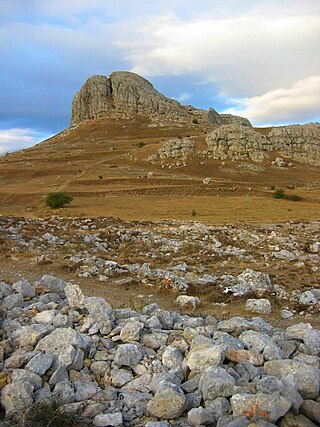
The Reconquista or the reconquest of al-Andalus was a series of military and cultural campaigns that European Christian kingdoms waged against the Muslim kingdoms following the Muslim conquest of the Iberian Peninsula by the Umayyad Caliphate, culminating in the reign of the Catholic Monarchs of Spain. The beginning of the Reconquista is traditionally dated to the Battle of Covadonga, in which an Asturian army achieved the first Christian victory over the forces of the Umayyad Caliphate since the beginning of the military invasion. The Reconquista ended in 1492 with the fall of the Nasrid kingdom of Granada to the Catholic Monarchs.

Pelagius was a Hispano-Visigoth nobleman who founded the Kingdom of Asturias in 718. Pelagius is credited with initiating the Reconquista, the Christian reconquest of the Iberian Peninsula from the Moors, and establishing the Asturian monarchy, making him the forefather of all the future Iberian monarchies, including the Kings of Castile, the Kings of León, and the Kings of Portugal.

The Kingdom of Asturias was a kingdom in the Iberian Peninsula founded by the Visigothic nobleman Pelagius. It was the first Christian political entity established after the Umayyad conquest of Visigothic Hispania in 711. In the Summer of 722, Pelagius defeated an Umayyad army at the Battle of Covadonga, in what is retroactively regarded as the beginning of the Reconquista.
Alfonso I of Asturias, called the Catholic, was the third king of Asturias, reigning from 739 to his death in 757. His reign saw an extension of the Christian domain of Asturias, reconquering Galicia and León.

Cantabria is an autonomous community and province in northern Spain with Santander as its capital city. It is called a comunidad histórica, a historic community, in its current Statute of Autonomy. It is bordered on the east by the Basque autonomous community, on the south by Castile and León, on the west by the Principality of Asturias, and on the north by the Cantabrian Sea, which forms part of the Bay of Biscay.

Oviedo or Uviéu is the capital city of the Principality of Asturias in northern Spain and the administrative and commercial centre of the region. It is also the name of the municipality that contains the city. Oviedo is located approximately 24 km (15 mi) southwest of Gijón and 23 km (14 mi) southeast of Avilés, both of which lie on the shoreline of the Bay of Biscay. Oviedo's proximity to the ocean of less than 30 kilometres (19 mi) in combination with its elevated position with areas of the city more than 300 metres above sea level causes the city to have a maritime climate, in spite of its not being located on the shoreline itself.

Aurelius was the King of Asturias from 768 to his death. Born in León, he was the son of Fruela of Cantabria ; nephew of Alfonso I of Asturias; and a cousin of his predecessor, Fruela I. His brother, Bermudo I, later reigned as king from 789 to 791.

The Kingdom of Castile was a polity in the Iberian Peninsula during the Middle Ages. It traces its origins to the 9th-century County of Castile, as an eastern frontier lordship of the Kingdom of Asturias. During the 10th century, the Castilian counts increased their autonomy, but it was not until 1065 that it was separated from the Kingdom of León and became a kingdom in its own right. Between 1072 and 1157, it was again united with León, and after 1230, the union became permanent.

Amaya is a village located in the municipality of Sotresgudo, Burgos, in the region of Castile-Leon, Spain.

Spain in the Middle Ages is a period in the history of Spain that began in the 5th century following the fall of the Western Roman Empire and ended with the beginning of the early modern period in 1492.
Uthman ibn Naissa better known as Munuza, was an Umayyad governor depicted in different contradictory chronicles during the Muslim conquest of Hispania.
This is a historical timeline of Portugal.

Sancho I of León, nicknamed Sancho the Fat was a king of León twice. He was succeeded in 958 by Ordoño IV and, on his death, by his son Ramiro.

The following is a history of Galicia, a subsection of the Iberian Peninsula.

The Asturian or Astur-Leonese dynasty, known in Arabic as the Banī Adhfūnsh, was the ruling family of the kingdom of Asturias and León from 739 until 1037. Under their rule, the Astur-Leonese kingdom went from a small mountain enclave to one of the dominant powers in Hispania.

Pre-Romanesque architecture in Asturias is framed between the years 711 and 910, the period of the creation and expansion of the kingdom of Asturias.
Adosinda was the queen of Asturias during the reign of her husband, Silo, from 774 to 783. She was a daughter of Alfonso I and Ermesinda, daughter of the first Asturian king, Pelayo. She was a sister of Fruela I.
Gausón was a semi-legendary Astur general who fought the Romans in the Astur-Cantabrian Wars.

Garci Lasso Ruiz de la Vega was a Spanish noble from Cantabria and one of the pillars in the history of the prominent contemporary House of Garci Lasso de la Vega or Garcilasco de la Vega. As the eldest son, Garci Lasso Ruiz de la Vega succeeded his father, Garci Lasso de la Vega II, as the head of his household.

Fruela of Cantabria or Fruela Pérez was the second son of Duke Peter of Cantabria and brother of King Alfonso I of Asturias.













